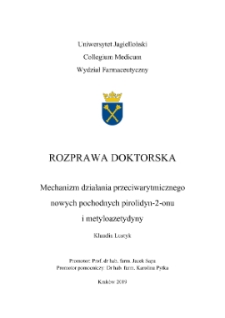Obiekt
Tytuł: The mechanism of antiarrhythmic activity of the new pyrrolidin-2-one and methylazetidine derivatives
Abstrakt:
The antiarrhythmic activity of the new pyrrolidin-2-one and methylazetidine derivatives was determined in this study and their mechanism of action was investigated. Most of the tested compounds showed affinity for α1-adrenergic receptors. The influence of studied derivatives on blood pressure response to methoxamine confirmed the antagonism against the α1-adrenergic receptors. None of the tested compounds prolonged the QTc interval, which may indicate a lack of proarrhythmic potential. Majority of tested compounds showed prophylactic antiarrhythmic activity in the adrenaline induced arrhythmia. Lack of affinity for β1-adrenergic receptors ultimately excluded the role of the β1-adrenolytic component in the mechanism of antiarrhythmic activity. None of the tested compounds restored the sinus rhythm and reduced the mortality in aconitine induced arrhythmia or showed significant activity in the model of calcium chloride induced arrhythmia. All compounds showed hypotensive activity, due to their α1-adrenolytic properties. AG-608 and S-75 were selected for extended studies. Both compounds showed weaker effects on calcium and potassium channels than reference compounds, which minimizes the contribution of these channels to their mechanism of action. AG-608 reduced the flow of sodium current stronger than dibukaine, which may confirm the participation of these channels in its antiarrhy ; thmic activity. In addition, AG-608 showed activity in the model of post-reperfusion arrhythmias of the isolated rat hearts. Both compounds acted therapeutically in the adrenaline induced arrhythmia.
Miejsce wydania:
Stopień studiów:
Dyscyplina:
farmakologia ; choroby układu krążenia
Instytucja nadająca tytuł:
Promotor:
Data wydania:
Identyfikator:
Sygnatura:
Język:
Prawa dostępu:
Kolekcje, do których przypisany jest obiekt:
Data ostatniej modyfikacji:
13 mar 2023
Data dodania obiektu:
11 sie 2020
Liczba wyświetleń treści obiektu:
8
Liczba wyświetleń treści obiektu w formacie PDF
0
Wszystkie dostępne wersje tego obiektu:
http://dl.cm-uj.krakow.pl:8080/publication/4369
Wyświetl opis w formacie RDF:
Wyświetl opis w formacie OAI-PMH:
| Nazwa wydania | Data |
|---|---|
| ZB-131958 | 13 mar 2023 |
Obiekty
Podobne
The mechanism of antiarrhythmic activity of the new pyrrolidin-2-one and methylazetidine derivatives
Lustyk, Klaudia
Knutelska, Joanna
Nowińska, Katarzyna
Rak, Aleksandra
The search for selective alfa1A and/or alfa1D-blockers among arylpiperazine derivatives of phenytoin
Nowiński, Leszek
Waligóra, Marcin
Baron, Tomasz
Rybka, Sabina

